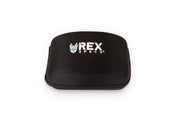 Just like with humans, we need to consider eye protection for dogs, as the sun's harmful UV rays can cause eye conditions like snow blindness, German Shepherd keratitis, sunburn around the eyes, and cataracts. Dog sunglasses like those from Rex Specs protect your dog's eyes not only from UV rays and sunlight, but also from dust and dirt, insects and wind, as well as injuries from sticks and thorns while rummaging through the undergrowth.
Just like with humans, we need to consider eye protection for dogs, as the sun's harmful UV rays can cause eye conditions like snow blindness, German Shepherd keratitis, sunburn around the eyes, and cataracts. Dog sunglasses like those from Rex Specs protect your dog's eyes not only from UV rays and sunlight, but also from dust and dirt, insects and wind, as well as injuries from sticks and thorns while rummaging through the undergrowth.
Can sunlight damage a dog's eyesight?
If you've ever taken a nap in the sun and woken up with a nasty sunburn, you know how unforgiving the sun can be. Light consists of a spectrum of waves, ranging from gamma rays and X-rays to radio waves and microwaves. Visible light lies in the middle. Slightly shorter wavelengths (closer to gamma rays) are the sun's harmful ultraviolet (UV) rays.
Sunlight and sun exposure can negatively impact your dog's eye health if they don't have the right protection. So that you and your four-legged friend can enjoy your next adventure without blinking and long-term side effects, learn how sunlight can affect dogs' eyesight and answer the question:
When does dog sunglasses make sense?
During activities with increased UV exposure.
Even healthy dog eyes can be damaged by high UV exposure. Just like humans, dogs can develop snow blindness. Snow blindness is damage to the outer cornea caused by strong UV radiation. Increased UV levels can be expected at altitudes above approximately 1,200 meters. UV protection for your dog is important for long hikes or stays in the mountains. In the mountains, too, but not only there, UV radiation is amplified by the reflection of sunlight. The reflection of sunlight at the sea or on a bright sandy beach can be just as dangerous for a dog's eyes.
As protection against UV-related diseases
Just like in humans, UV light or UV radiation can be harmful to your dog's eyes and skin. In addition to painful sunburns and an increased risk of skin cancer, these short-wave UV rays can also penetrate the eye tissue and impair its function.
Using dog sunglasses as UV protection for German Shepherd Keratitis
German Shepherd Keratitis, or Chronic Superficial Keratitis (CSK), is one of the main reasons founders Aiden and Jesse Emilo started Rex Specs—their dog, Tuckerman, was diagnosed with pannus at age 2. Pannus is a progressive autoimmune disease that attacks the cornea (the clear part of the eye). UV radiation is one of the main factors that can aggravate and inflame German Shepherd Keratitis. The inflammation of the condition causes a buildup of scar tissue around the eye, eventually leading to severe vision loss and blindness. Some breeds, such as German Shepherds, Border Collies, and Greyhounds, have a genetic predisposition to this type of keratitis, but any dog can develop it. German Shepherd Keratitis is more likely to occur in dogs living at high altitudes, due to their greater exposure to UV radiation.
If you would like to learn more about this disease, please see our blog: Comprehensive Guide to Pannus (German Shepherd Keratitis) in Dogs .
Protection against sunburn in dogs with lack of pigmentation
Dogs with light-colored eyes or a lack of pigmentation around the nose and eyes are just as susceptible to sunburn as humans. On sunny days, especially at higher elevations, UV rays can inflame and irritate your dog's eyes. If you see your dog squinting in the sunlight or struggling to keep his eyes open after a long day in the sun, it could mean his eyes are under a lot of sun strain. Another, more cumulative effect of UV radiation is certain types of skin cancer. Just as in humans, overexposure to the sun damages dogs' skin, causing cancers such as squamous cell carcinoma, malignant melanoma, and hemangiomas. This is especially true for short-haired dogs or dogs with light-colored coats.
The Emilos' deceased Alaskan Husky, Yaz, regularly struggled with sunburns on her pigmentless skin around her eyes. This inspired the couple to develop Rex Specs to protect her eyes.
Eye diseases in dogs related to sunlight
When it comes to bright light or sunlight, dogs are arguably more sensitive to it than humans. Dogs evolved as crepuscular animals, while humans are diurnal. For this reason, dogs' eyes are more light-sensitive, allowing them to see better in dim light conditions, while humans' eyes are more adapted to brighter light conditions. This also means that dogs that spend a lot of time in bright or glaring sunlight have impaired vision and can even be damaged.
Iris atrophy in dogs
Iris atrophy is the degeneration of the iris muscle (the colored part of the eye). This is a common aging condition that makes it difficult for your dog to constrict their pupils, making them more sensitive to bright light. This can cause your dog to blink more on a sunny day and be less comfortable in bright light.
Dog sunglasses for day blindness
Day blindness, or achromatopsia, is a congenital eye condition that affects your dog's cone photoreceptors, which help your dog see and recognize colors in moderate to bright light. With day blindness, your dog's cones slowly begin to fail and disappear, leaving them unable to see during the day. However, the other type of photoreceptors—the rods—which work in dim light and detect movement, are unaffected, meaning your dog's night and low-light vision is fine. Hence the name day blindness. You can find out more about how dogs see in our blog: How do dogs see?
How can I reduce the effects of sun exposure on my dog?
The best way to protect your dog from the sun is to keep him out of the sun, but we believe the cure shouldn't be worse than the disease. Therefore, our recommendations for reducing sun exposure while still allowing him to enjoy all outdoor activities are:
Use Rex Specs UV eye protection: Rex Specs dog sunglasses offer UVA and UVB protection, blocking 99.9% of harmful UV rays. Reliably and safely during almost any activity.
Other uses for dog goggles
It's not just sick dogs that need safety goggles or dog sunglasses. It's actually quite simple: wherever you wear safety goggles yourself, they can't harm your dog. Whether you're driving in an open convertible, on a motorcycle sidecar, in a bike trailer or cargo bike, or driving with the side window of your car open, dog goggles can prevent eye infections caused by the wind and injuries from flying insects and small stones. Even blind dogs wear our goggles. This prevents eye injuries from protruding branches when rummaging through the bushes. Rex Specs provide reliable protection when hunting and tracking through, for example, a cornfield, reeds, or dense undergrowth. Police, military, or border patrol dogs use our dog safety goggles to protect the eyes of their four-legged friends and colleagues.
Here you will find the 5 most common reasons for the Rex Specs dog glasses
What should I look for when buying dog glasses?

- UV protection isn't just important for dogs with sore eyes. Exposure is highest in the mountains above approximately 1,000 meters above sea level and near bodies of water. Therefore, all lenses, even clear lenses with UV400 filters, should offer 99.8% UV-A and UV-B protection.

- Warm air that builds up behind the lens should be able to escape upwards. The ventilation openings should be covered; for example, a high-quality mesh fabric can prevent foreign objects from entering the interior of the goggles. Dust, sand, and even insects stay out.

- In summer, most dogs want to cool off in the water and love to swim. A good pair of dog goggles fits securely and ensures that the goggles won't get lost in the water. Any water that gets in should be able to drain away immediately. It's also important that the dog can be cleaned with water during grooming.

- A thick, all-round padding, ideally with an additional soft fleece fabric, ensures very good wearing comfort, so your dog can then use/wear the goggles for many hours at a time.

- A flexibly adjustable harness system is also important for comfort. Harness straps should be individually adjustable to your dog's head shape and size. This is the only way to prevent pressure points and chafing. An elastic section on the harness near the chin allows your dog to pant, eat, drink, and bark.

- A large, continuous lens offers a large field of vision; if it is spherically curved, there is enough space for fur and whiskers, which in turn increases acceptance.

- In addition to a large field of vision, the screen should offer a high level of protection. This includes repelling foreign objects and preventing the screen from shattering.

- A lightweight frame increases comfort and acceptance of the glasses. However, it's important that the frame is robust and can withstand a certain amount of wear and tear without being rigid and bulky. A flexible frame can adapt better to the dog's head.
Further applications for the Rex Specs dog glasses
It's not just sick dogs that need protective goggles. It's actually quite simple: wherever you wear protective goggles yourself, they can't harm your dog. Whether you're driving in an open convertible, in a motorcycle sidecar, in a bike trailer or cargo bike, or driving with the side window of your car open, dog goggles can prevent eye infections caused by the wind and injuries from flying insects and small stones. Even blind dogs wear our goggles. This prevents eye injuries from protruding branches when rummaging through the bushes. Rex Specs are also used successfully in hunting. Rex Specs provide reliable protection when hunting and tracking through a cornfield, in reeds, or in dense undergrowth. Police, military, or border patrol dogs use our goggles to protect the eyes of their four-legged friends and colleagues.




